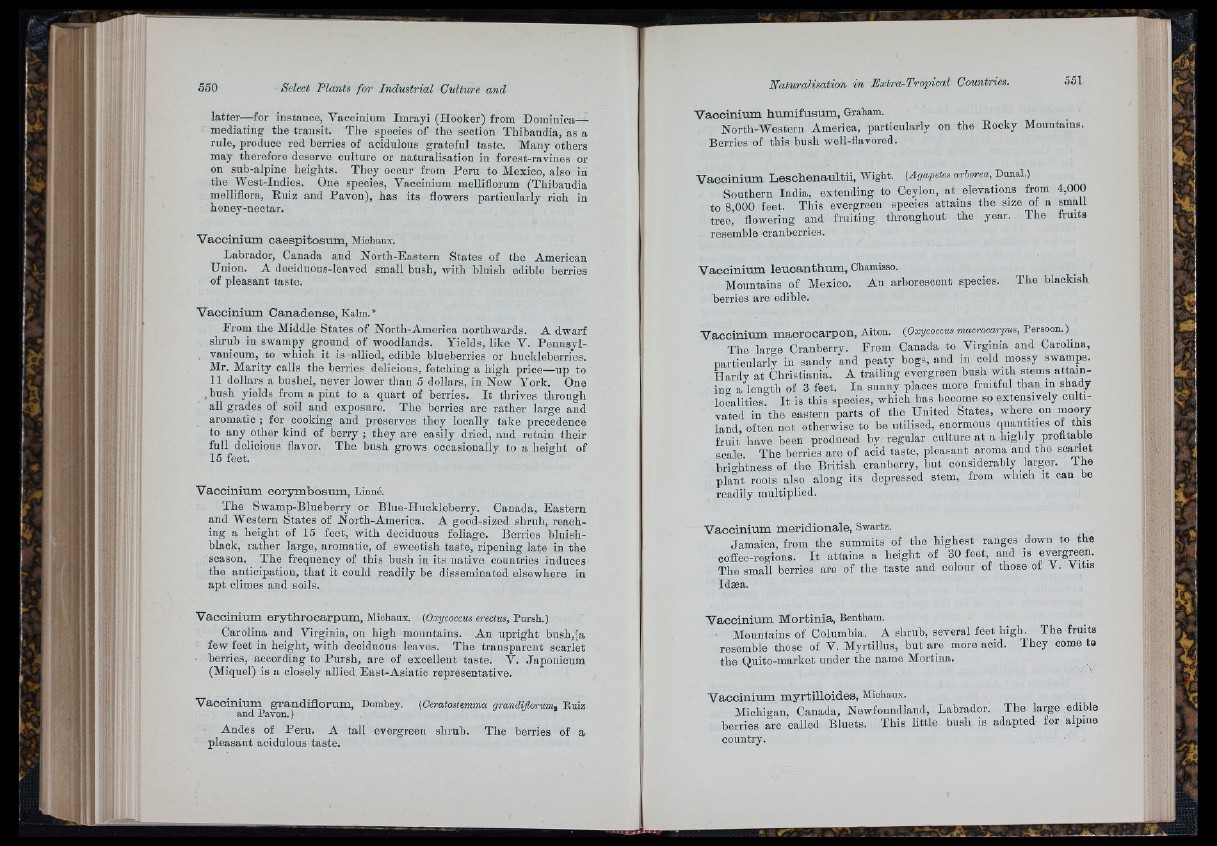
latter—for instance, Vaccinium Imrayi (Hooker) from Dominica—
mediating the transit. The species of the section Thihaudia, as a
rule, produce red berries of acidulous grateful taste. Many others
may therefore deserve culture or naturalisation in forest-ravines or
on snb-alpine heights. They occur from Peru to Mexico, also in
the West-Indies. One species, Vaccinium melliflorum (Thihaudia
melliflora, Ruiz and Pavon), has its flowers particularly rich in
honey-nectar.
Vaccinium caespitosum, Michaux.
Labrador, Canada and North-Eastern States of the American
Union. A deciduous-leaved small bush, with bluish edible berries
of pleasant taste.
Vaccinium Canadense, Kalm.*
From the Middle States of North-America northwards. A dwarf
shrub in swampy ground of woodlands. Yields, like V. Penngyl-
vanicum, to which it is allied, edible blueberries or huckleberries.
Mr. Marity calls the berries delicious, fetching a high price—up to
11 dollars a bushel, never lower than 5 dollars, in New York. One
,busli yields from a pint to a quart of berries. I t thrives through
all grades of soil aud exposure. The berries are rather large and
aromatic ; for cooking and preserves they locally take precedence
to any other kind of berry ; they are easily drieffl and retain their
full delicious flavor. The bush grows occasionally to a heiarht of
15 feet.
Vaccinium corymbosum, Linné.
The Swamp-Blueherry or Blue-Huckleberry. Canada, Eastern
and Western States of North-America. A good-sized shrub, reaching
a height of 15 feet, with deciduous foliage. Berries bluish-
black, rather large, aromatic, of sweetish taste, ripening late in the
season. The frequency of this bush in its native countries induces
the anticipation, th a t it could readily be disseminated elsewhere in
apt climes and soils.
Vaccinium erythrocarpum, Michaux. (Oxycoecus erectus, Pursh.)
Carolina and Virginia, on high mountains. An upright bush,(a
few feet in height, with deciduous leaves. The transparent scarlet
berries, according to Pursh, are of excellent taste. V. Japonicum
(Miquel) is a closely allied East-Asiatic representative.
Vaccinium grandiflorum, Dombey. [Ceratostcmma grandiflortim, Euiz
and Pavon. )
Andes of Peru. A tall evergreen shrub. The berries of a
pleasant acidulous taste.
Vaccinium humifusum, Graham.
North-Western America, particularly on the Rocky Mountains.
Berries of this bush well-flavored.
Vaccinium Leschenaultii, Wight. (Agapetes arborea, Dunal.)
Southern India, extending to Ceylon, at^ elevations from 4,000
to 8,000 feet. This evergreen species attains the size of a small
tree,’ flowering and fruiting throughout the year. The fruits
resemble cranberries.
Vaccinium leucanthum, Chamisso.
Mountains of Mexico. An arborescent species. The blackish
berries are edible.
Vaccinium macrocarpon, Aiton. (Oxycoccus macrocarpus, Persoon.)
The large Cranberry. From Canada to Virginia and Carolina,
particularly in sandy and peaty bogs, and in cold mossy swamps.
Hardy at Christiania. A trailing evergreen bush with stems attain ing
a length of 3 feet. In sunny places more fruitful than in sha,dy
localities I t is this species, which has become so extensively cultivated
in the eastern parts of the United States, where on moory
land, often not otherwise to be utilised, enormous quantities of this
fruit have been produced by regular culture a t a higlily profitable
scale The berries are of aoid taste, pleasant aroma and the scarito
brightness of the British cranberry, hut considerably larger. The
plant roots also along its depressed stem, from which it can be
readily multiplied.
Vaccinium meridionale, Swartz.
Jamaica, from the summits of the highest ranges down to the
cofiee-regions. I t attains a height of 30 feet, and is evergreen.
The small berries are of the taste and colour of those of V. Vitis
Idsea.
Vaccinium Mortinia, Bentham,
' Mountains of Columbia. A shrub, several feet high. The fruits
resemble those of V. Myrtillns, hut are more acid. They come to
the Quito-market under the name Mortina.
Vaccinium myrtilloides, Miohaux.
Michigan, Canada, Newfoundland, Labrador. The large edible
berries are called Bluets. This little bush is adapted for alpme
country.